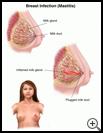
Breast Infection (Mastitis)
________________________________________________________________________
KEY POINTS
- Mastitis is an infection in your breast, usually caused by bacteria, and is more likely to happen when you are breastfeeding.
- Treatment may include antibiotic medicine and pain medicine.
- Breastfeed your baby more often. You may need to use a breast pump to help drain milk from the infected side.
________________________________________________________________________
What is mastitis?
Mastitis is an infection in your breast, usually caused by bacteria. You are more likely to have a breast infection when you are breastfeeding.
What is the cause?
The most common reasons that breasts get infected are:
- Poor drainage of milk from the breasts. This may happen if there is too much time between feedings or you skip or miss feedings. If your baby feeds only on one side or does not drink enough milk, milk can build up in your breast. Also, milk may not drain well if you have a clogged milk duct or your bra fits too tightly.
- Injury to the breast. It’s common to have bacteria on your nipple and in your baby's mouth. If your nipple is injured and cracked, the bacteria may get into the milk ducts in your breast and cause an infection. Your nipples can get injured if your baby latches incorrectly onto your breast while breastfeeding, causing a crack or open sore. An older baby may bite the nipple or kick your breast. Using a breast pump with a vacuum that is too strong can also injure your breast.
What are the symptoms?
Symptoms may include:
- Achy, flulike feeling
- Fever or chills
- Lump in your breast
- Headache
- Breast pain, redness, or swelling
- Trouble getting milk to flow
How is it diagnosed?
Your healthcare provider will ask about your symptoms and medical history and examine you.
How is it treated?
Your healthcare provider may prescribe antibiotic medicine to treat the infection. The sooner you start treatment, the sooner you will feel better. Your provider may also recommend a pain reliever until the infection is gone.
The infection usually does not pass to your baby. If you are taking an antibiotic, the baby will get some of the medicine through the breast milk. That is usually not a problem for the baby. Your healthcare provider will choose an antibiotic medicine that is safe for your baby. Talk to your child’s healthcare provider if you have concerns.
Your provider will also check to make sure that your baby is emptying your breasts during feeding, that you are breastfeeding often, and that your baby latches on correctly. A lactation consultant can help you if you have questions. Also, using a breast pump to keep milk flowing can help.
How can I take care of myself?
- Rest and stay in bed as much as possible for the first 24 hours.
- Drink plenty of liquids, especially if you have a fever.
- Eat a variety of healthy foods.
- Nonprescription pain medicine may help. Talk to your healthcare provider before you use any medicine to be sure that the medicine is OK for you to use.
- Breastfeed more often to keep your breasts well drained. Warm your breast just before breastfeeding. Heat improves blood flow and helps your milk let-down. Try taking a warm shower just before feeding or cover your breasts with a warm washcloth. You can put a plastic diaper over the washcloth to keep the heat in. Start feedings on the side that is not infected and then move your baby to your infected breast after the let-down of milk has been triggered.
Make sure your baby’s healthcare provider knows what antibiotic medicine you are taking. Your baby can still drink the breast milk.
- You may need to use a breast pump if:
- The infected breast is not draining well even though you have followed the treatment suggestions.
- Breastfeeding your baby from the infected breast is too painful.
- Your baby refuses to breastfeed from the infected breast.
Follow the full course of treatment prescribed by your healthcare provider. Take all the antibiotic medicine your healthcare provider prescribes even if you feel much better after a few days. Ask your provider:
- How long it will take to recover
- If there are activities you should avoid and when you can return to normal activities
- How to take care of yourself
- What symptoms or problems you should watch for and what to do if you have them
Make sure you know when you should come back for a checkup.
Last modified: 2021-12-07
Last reviewed: 2019-04-09

